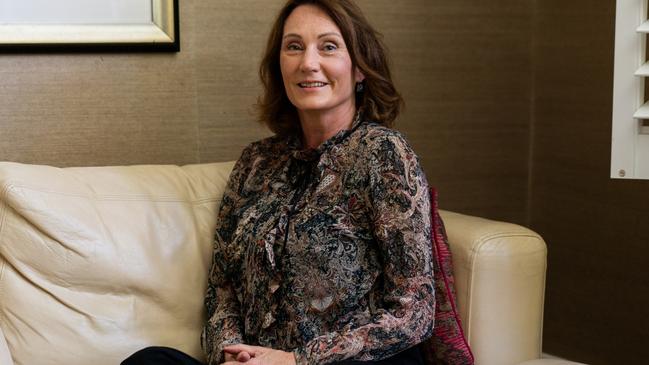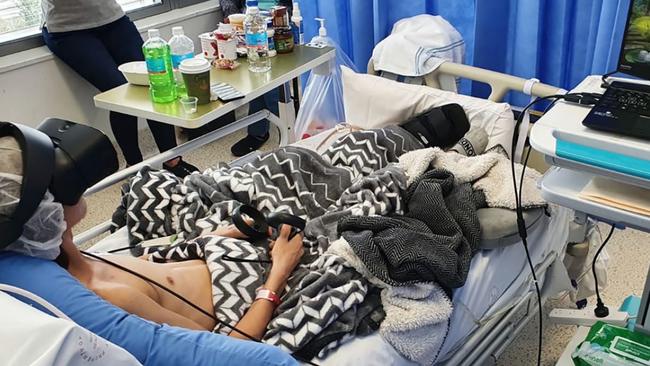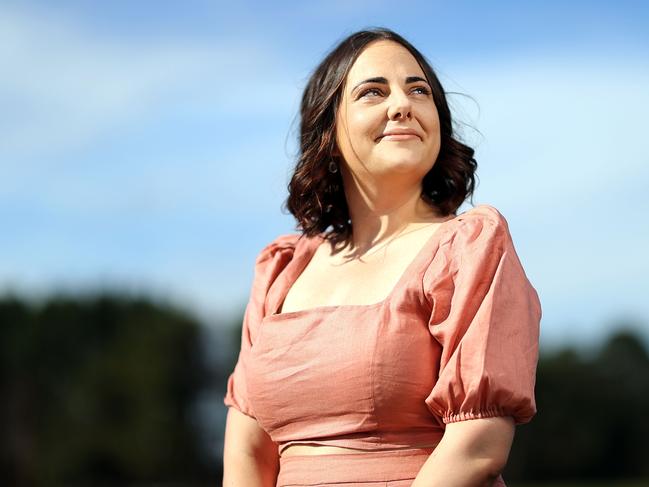Groundbreaking new ways of treating chronic pain
The male hormone testosterone, virtual reality and clever devices are among the latest breakthroughs in pain management that could help one in five Aussies struggling with the condition.
National
Don't miss out on the headlines from National. Followed categories will be added to My News.
Exclusive: One in five Australians will develop chronic pain in their lifetime — and sufferers are most likely to be women of working age.
Pain is a leading cause of suicide and it costs the economy nearly $140 billion a year.
Making matters worse, many pain conditions are being managed poorly, with sufferers dependent on harmful medications.
But as SUE DUNLEVY reports major advances in understanding the condition are behind innovative new treatment options.
NEW PAIN THEORY
Traditionally pain was thought to be a bottom up process – damage to the body prompted events in the brain that made the body recognise it was in pain.
Now researchers have shown some pain — including fibromyalgia, complex regional pain syndrome and chronic back pain — is caused by malfunctioning of the immune system and the pain signalling apparatus in the central nervous system.
Women are more likely to experience chronic pain than men because their immune systems are more active. It means they die less in a pandemic, but the price is a higher rate of auto-immune conditions and chronic pain, gynaecologist and researcher Associate Professor Susan Evans said.
The best way to manage pain is to get moving. Physiotherapy and psychology is important in giving people the confidence to do this, pain expert Professor Michael Vagg said.

HORMONAL HELP
Giving women the male hormone testosterone could be the answer to curing chronic pain like endometriosis, migraines and fibromyalgia, rheumatoid arthritis and multiple sclerosis. Associate Professor Susan Evans’ research found women with lower levels of testosterone suffer more days of pelvic pain than women with higher levels and men with lower levels of testosterone are more likely to suffer inflammatory conditions like rheumatoid arthritis. In the United States, doctors have begun using testosterone to alleviate pain caused byfibromyalgia and some doctors in Australia are using it off label for this purpose.
OVERUSING PAIN PILLS
Medications which help control pain can cause chronic pain if over used. High dose opioids taken long term can cause worse pain. Neurologist and migraine expert Professor Richard Stark said medication overuse headaches happen once a person uses drugs such as codeine, barbiturates or even triptans more than twice a week. Even paracetamol can cause headaches if it is used once a day, he said. To beat the cycle, patients have to be weaned off their medication.

VIRTUAL REALITY
Virtual reality headsets that offer games, scenes or psychological breathing therapies to distract are helping people manage chronic back pain and the agony caused by changing the dressings of burns patients. They have even been found to help women deal with the pain of childbirth. In November last year, the US FDA approved a new virtual reality system to treat back pain called EaseVRx. It can be used at home and consists of a VR headset, a controller, and “Breathing Amplifier” that directs a patient’s breath toward the headset’s microphone for use in deep breathing exercises. It offers deep relaxation, attention-shifting, distraction, immersive enjoyment, self-compassion, healthy movement and other techniques to relieve pain. Nearly half (46 per cent) of those using the VR therapy had a 50 per cent or greater reduction in their pain compared to 26 per cent of those not using it. Professor Steven Faux, at Sydney’s St Vincent Hospital, is working with Samsung Australia trialling virtual reality to manage pain.
PREVENTING PELVIC PAIN
Australian researchers plan to trial devices implanted in the uterusto reduce and prevent pelvic pain in women. The devices, being made by medical company Alyra Biotech, use a drug to control the immune system within the uterus and prevent it causing pain via the central nervous system. Assoc. Prof. Evans said the device “has strong potential to really address some of the unmet needs of women that haven’t had the treatment options they deserve for a long period of time so we’re very excited about it”.
EDUCATING KIDS
The Pelvic Pain Foundation of Australia’s Periods, Pain and Endometriosis (PPEPTalk) Schools Program is available now in all States. It helps teens understand if their pain is normal, and what to do if it isn’t. And they also help boys learn how to best support the women in their life who may be suffering pain.
KNEE SURGERY PAIN
A two-page survey to be given to knee surgery patients aims to predict the 15 per cent of patients who will experience ongoing pain after surgery and intervene to prevent it. Prof. Vagg will use the research to make it easier to identify patients who have chronic pain that’s not getting better in the normal time frame after surgery and take action early to prevent it going on to become a lifelong problem.

MIGRAINE
Millions of Australian migraine sufferers may not be getting high enough doses of medicine to cut their pain. Australian neurologist Professor Peter Goadsby, who works at King’s College London, said the typical 70 kilogram patient needs 900 milligrams of aspirin to relieve migraine pain not the standard 600 mg dose. Medications to prevent migraines such as blood pressure medication propranolol (Inderal) and anti-epileptics such as Topamax are often not given in high enough doses to make a difference. A new class of medicines to treat and prevent migraines, called Calcitonin Gene Related Peptide (CGRP) inhibitors, are available. Two of these – Emgality and Ajovy – are subsidised on the PBS. Botox can be used to prevent migraines if you have more than 15 migraines per month. It is injected into 31 different sites in the head and neck every three months. There is evidence a neuromodulation headband called Cephaly which sends electrical signals to the brain reduces migraines in 38 per cent of patients. Another Gammacore device applied to the vagus nerve reduces headaches in around half of all patients if used for 8 months. Using the drug naproxen for 7 to 14 days before a period can help reduce menstrual-related migraines.
LIVING WITH CHRONIC PAIN
Megan Kuleas is cheerful and positive but admits it’s a defence mechanism to protect her friends and family from worrying about her debilitating chronic pain.
The 32-year-old public servant was diagnosed with Poly-Cystic Ovarian Syndrome and endometriosis in 2008.
Multiple surgeries were unsuccessful and she has since been diagnosed with Adenomyosis, which sees the inner lining of the uterus breaks through the muscle wall of the uterus, and a heart condition.
“I’m always in pain and the severity ranges. Some days I’m fine and some days I’m bedridden and suffering from other side effects like vomiting and fainting,” she said.
Managing her condition is complex and involves a whole team.

“I do take medication but I also exercise and meditate and look after my mental health and see an acupuncturist, use Chinese herbal medicine, physiotherapy and I also have a neuro modulation modulator system that was implanted last year,” she said.
“I get some relief, it definitely takes the edge off having a holistic approach but I’m yet to find something that completely resolves my pain,” she said.
“I feel I’m always cancelling on friends and family because I’m just too tired or I’m just in so much pain and that can be quite hard feeling that you’re letting people down or that you’re not able to achieve what you think that you’re meant to.”
It is important to remember that your chronic pain does not define you, it is only a small part of who you are, she said.
More Coverage
Originally published as Groundbreaking new ways of treating chronic pain





